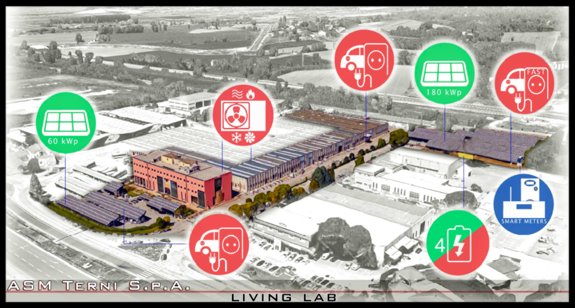The Smart Energy Living Lab in Terni stands as a beacon of innovation, providing an ideal platform for the exploration and showcasing of cutting-edge technologies and models in the realm of smart energy. In an era where decentralized renewable energy sources pose both opportunities and challenges to the existing distribution network, the Living Lab serves as a real-world testing ground. By replicating actual operating conditions, the Living Lab not only addresses the practical challenges of decentralized energy generation but also plays a crucial role in shaping the future of the energy landscape, paving the way for sustainable and efficient models to thrive in the market.
The living lab of ASM headquarters district includes two substations, a distribution feeder network branch comprising decentralized RES generation (240 kW peak power PVs), controllable loads (via Building Energy Management System), HVAC (around 100-120 kW), and three EV charging stations (two at 22 kW and one at 50 kW). Additionally, there’s a biodiesel cogenerator and a hybrid power grid handling both direct and alternating current, currently in the construction phase.

The living lab also includes a total of 150 near real-time IoT smart meters deployed in multi-apartment residential buildings, public schools equipped with PV local generation, and households with residential consumers equipped with PV. Ten IoT analyzers have been deployed in the secondary stations to monitor electric parameters. These are three-phase power meters capable of measuring current, voltage, and power on up to four electric lines connected to the same node. Data are transmitted via ethernet or 4G to the LV SCADA.
A state-of-the-art Scalable SCADA System has been integrated with part of the LV network to monitor data from sensors and IoT devices deployed throughout the grid. This real-time platform ensures reliable grid performance and allows for continuous enhancements in visibility. One of the standout features is its openness, allowing other software experts to create customized apps that can seamlessly connect different types of technology without causing problems. This helps make operations smoother and more efficient while improving the visibility of the grid. The System Platform is a versatile and collaborative tool that streamlines operations, promotes continuous improvement, and is able to communicate with every device or back-end system by using standard interfaces such as OPCUA, OPC DA, SQL, SOAP, HTTP/S, .NET.
